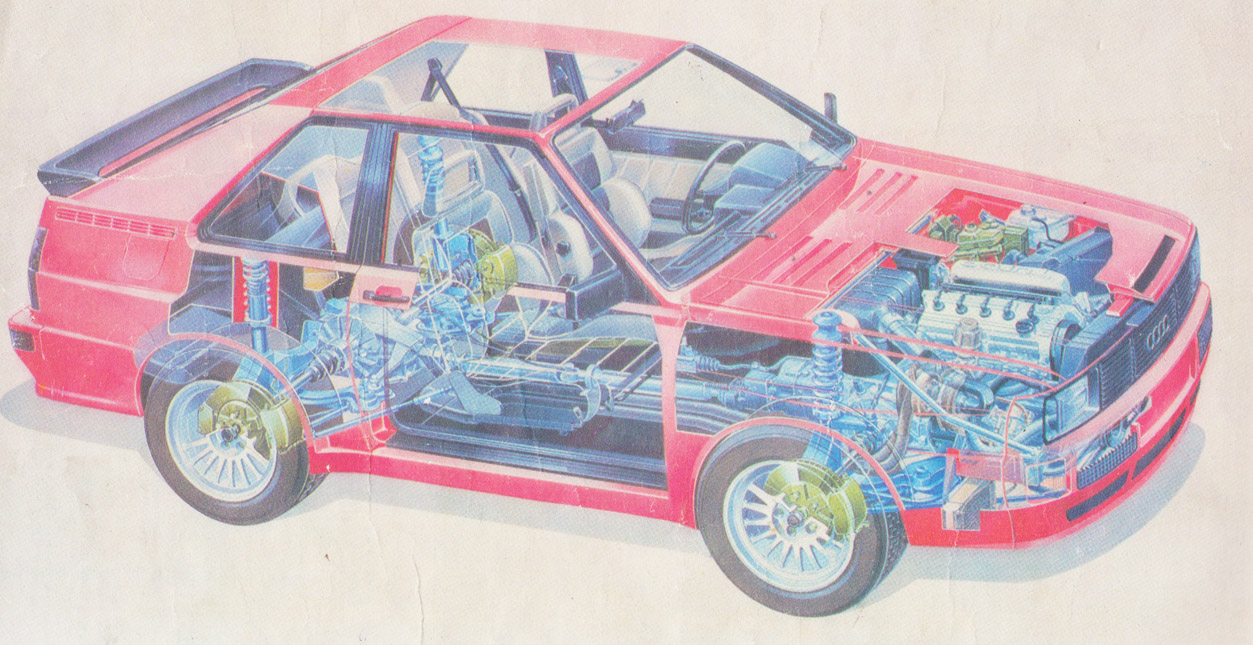 The 4X4 drive used in this car turned out to be the optimal solution, as it provides greater directional efficiency and an almost neutral cornering behavior, taking turns at high speeds, even wear of tires and less influence of driving forces on the steering. The above advantages make, that the Quattro is a safe vehicle suitable for all roads. No wonder then, that "ordinary" vehicle users are also interested in Quattro cars.
The 4X4 drive used in this car turned out to be the optimal solution, as it provides greater directional efficiency and an almost neutral cornering behavior, taking turns at high speeds, even wear of tires and less influence of driving forces on the steering. The above advantages make, that the Quattro is a safe vehicle suitable for all roads. No wonder then, that "ordinary" vehicle users are also interested in Quattro cars.
The most interesting thing about the Quattro is, of course, the drivetrain, characterized by low weight and high compactness. Of particular interest is the center differential located in the gearbox housing, which prevents energy losses in the form of power circulating between the two main gears. This mechanism can be blocked while driving at any speed, which prevents the reduction of the driving force of the wheels on one axle, when the wheels of the second axle lose their grip with the ground. The rear main gear also has a lock, which can also be used while driving. An additional advantage of having locking mechanisms is this, that when they are turned on, the braking performance of the vehicle increases and is close to this, provided by the electronic anti-blocking system (ABS).
Model 1984 has a completely revised interior, and the equipment includes, among others, an electronic warning system with a human voice synthesizer. An engine is installed in the Quattro 2,2 dm3 of capacity 147 kW, which allows you to travel at maximum speed 222 km/h; acceleration is from 0 do 100 km / h in time 7,1 s.
Regarding the fact, that the advantages of the Quattro are not only in demand in sports driving, Audi for a year 1985 put into production one version of the Quattro of each model. So after the Audi Quattro it was put into production Audi 80 Quattro, which on the outside does not differ in any way from an average passenger car. It has an engine with a capacity 1994 cm3 of power 85 kW at 5400 RPM. It is of course, similar to other models, a five-cylinder unit with a compression ratio 10. Audi 80 Contrary to the claims of its opponents, the Quattro is not an uneconomical car, because when driving at speed 90, 120 km / h and in the city it consumes accordingly 7,1/8,9/13,5 dm3 of fuel per 100 km.
The most interesting variant of the 4X4 is the Audi Quattro Sport, which is a modification of the Audi Quattro model.
This vehicle has a shortened wheelbase by 320 mm do 2204 mm and numerous body elements made of materials - glass and carbon fibers. Application of tires 225/50 VR 15 in place of 205/60 VR 15 required the appropriate profiling of the fenders. The braking system has also been strengthened by introducing four-cylinder disc brakes and ribbed, thick discs 28 mm.
The turbo-charged engine of the fourth generation in Audi deserves attention 200 - 3rd generation. It has a displacement 2133 cm3 (piston diameter / stroke - 79,3/86,4 mm), compression ratio 8,0. The body and head are made of aluminum alloy, which ensures a very low engine weight - 145 kg, The body itself is Fr. 23 kg lighter than a cast iron body, used in Audi engines 2,2 dm3.
There are four valves driven by two camshafts per engine cylinder. For the first time in a construction of this type, the valves are placed asymmetrically. Outlets are parallel to the plane passing through the axes of the cylinders, and the intake deflected from this plane by 25 °. This solution made it possible to reduce the dimensions of the head and to shape the combustion chamber more favorably.
There is a charge air cooler in the turbocharger system, which ensures the reduction of its temperature after leaving the compressor from 140 do 60° C, which increases the filling of the cylinder (lower air density). The absolute boost pressure in the Audi Quattro Sport engine comes to an end 0,22 MPa.
The Audi sixteen-valve engine has very good parameters. In particular, the almost linear torque curve over a large speed range is of interest.